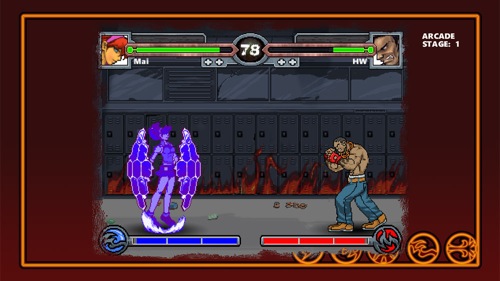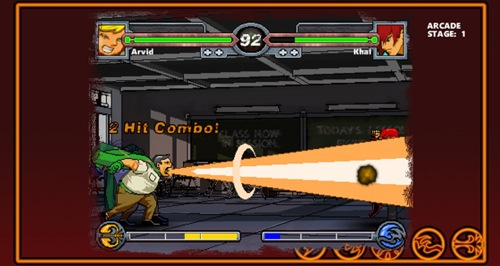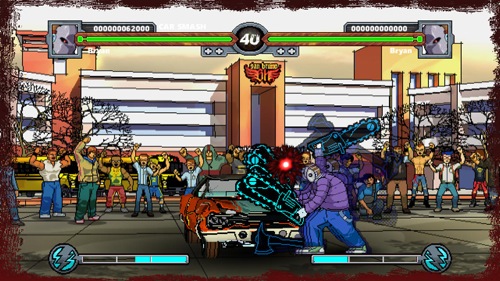Sometimes the most difficult task to keep in mind when writing a review is to criticize the thing being reviewed for what it is and not for what it isn’t. This is especially true when it comes to Indie games, as they’re always low budget and not meant to emulate or compete with blockbuster titles. For a game like Battle High: San Bruno, comparing it to industry established fighters like Mortal Kombat or Street Fighter IV is both pointless and unfair. Battle High: San Bruno is a competent 2D fighter that has a distinctly classic feel both in terms of its visuals and sounds.
Battle High is anything but a modern fighter. For the most part the game seems to be stuck in the 90’s with its emphasis on character-specific techniques and powerful special attacks. The game features the typical button configuration for the 8 playable fighters, with each of the face buttons corresponding to light/heavy punches and kicks. The player has the choice to use either the d-pad or the left analog stick to move, and believe me, this is a godsend, as most special techniques are much easier to pull off with the d-pad. These powerful specials are dependent upon a charge bar which gains steam as the player blocks or takes/receives damage. Most special attacks are very powerful, shaving off about a third of the opponent’s health, but they are far too easy to block, interrupt, or avoid altogether.

Mattrified Games’ Indie fighter features 4 game modes including the standard arcade mode, versus mode, challenge mode, and “extracurriculars,” which range from beating the living hell out of a car as fast as you can to dodging a barrage of sporting equipment at the gym. Each mode, while certainly not groundbreaking, is unique and fun in its own way. It really makes for a surprising amount of content and is one of the game’s many strong points. Unfortunately, Battle High isn’t flawless.
The game’s main shortcoming is its difficulty, or lack thereof. In the options menu, the player has the choice of a difficulty setting between 1 and 8, with 8 being the toughest. Unfortunately, there isn’t much separating the 1’s from 8’s since the AI seems to have a preconceived notion of backing itself into a corner no matter their supposed skill level. The most puzzling part about the difficulty is that it seems to depend more upon the specific character you’re fighting rather than the actual numerical value. For example, Khai is the only character I’ve ever lost to on max difficulty, and I’m far from a skilled player when it comes to fighters. However, there’s another loophole I discovered while being frustrated with the increased difficulty in facing Khai. If I was way behind in the round, it was very easy to spam either the right bumper or right trigger, both of which initiate a flying kick type move that’s standard for every character. The AI was dumbfounded, and although it was frequently able to block the attack, all too often it eventually succumbed to the onslaught. The lesson to take away here is that if you want a challenge, arcade mode isn’t where you’ll find it. Either try playing against a friend or try out the challenge mode if you’re really itching for a close fight.

A couple of things that surprised me the most regarding Battle High were the character development and the backstory. For a $1 Indie game, I certainly did not expect to be treated to character biographies for each student as well as a story arc surrounding and linking each character. The storyline is best compared to X-Men, as San Bruno is home to a school for gifted “elementals” where the students are segregated from the general public due to their otherworldly powers. In stark contrast to X-Men however, there seems to be no guiding force for the students, which leaves them free to unleash their elemental powers on each other in the various locales throughout the school. As each character proceeds through these stages in the game’s arcade mode, their personalities come out through dialogue with their opponents and even a unique cinematic when the mode is completed.

While I enjoyed the classic fighting and the tidbits of story sprinkled throughout the arcade mode, the music is really what ties the experience together. Each character has his/her own theme that’s about 30-45 seconds in length and loops throughout the battles. This may seem annoying at first, but the tunes are so catchy that I’d gladly pay another dollar just to have unlimited access to the upbeat electronic tracks.